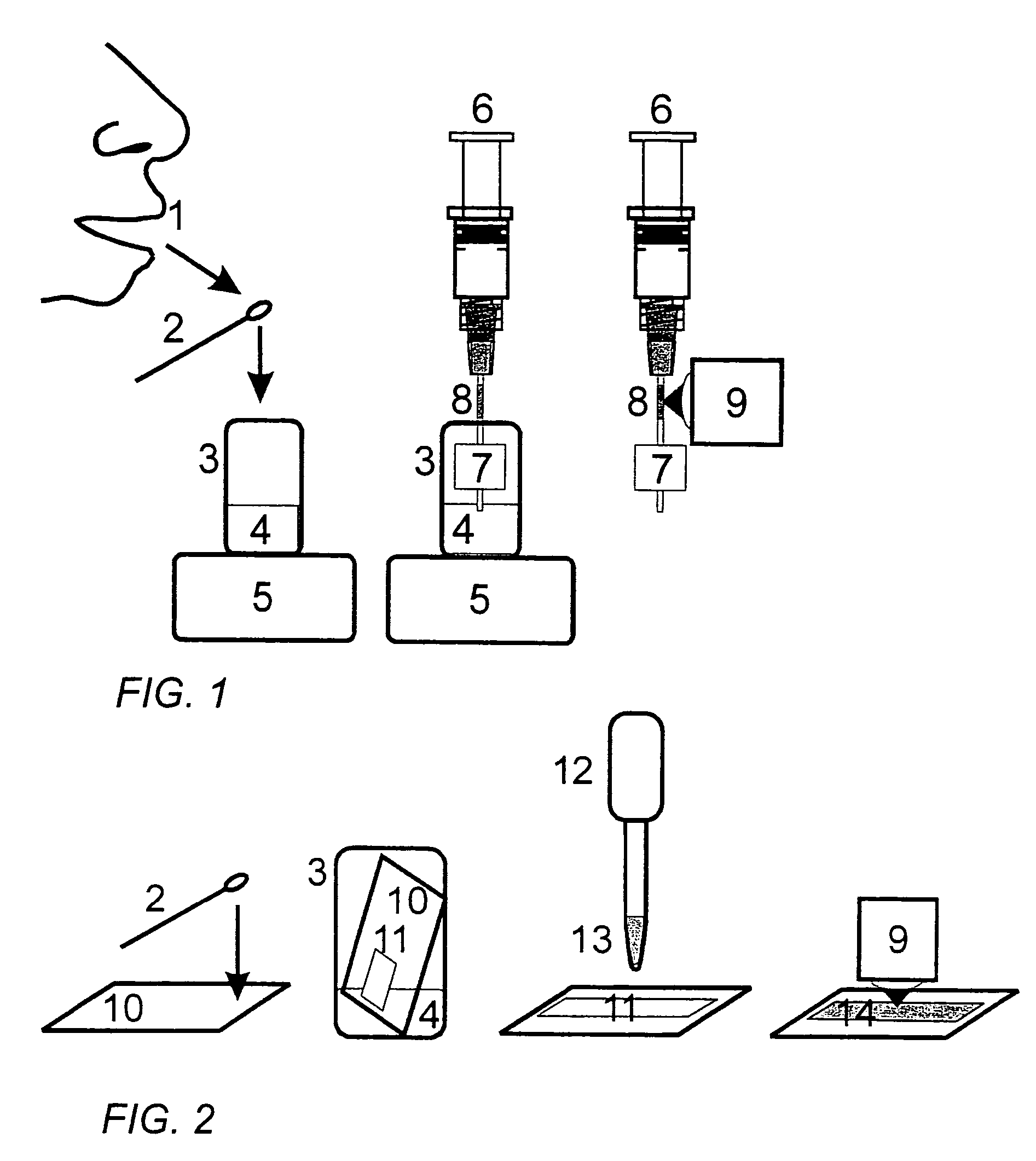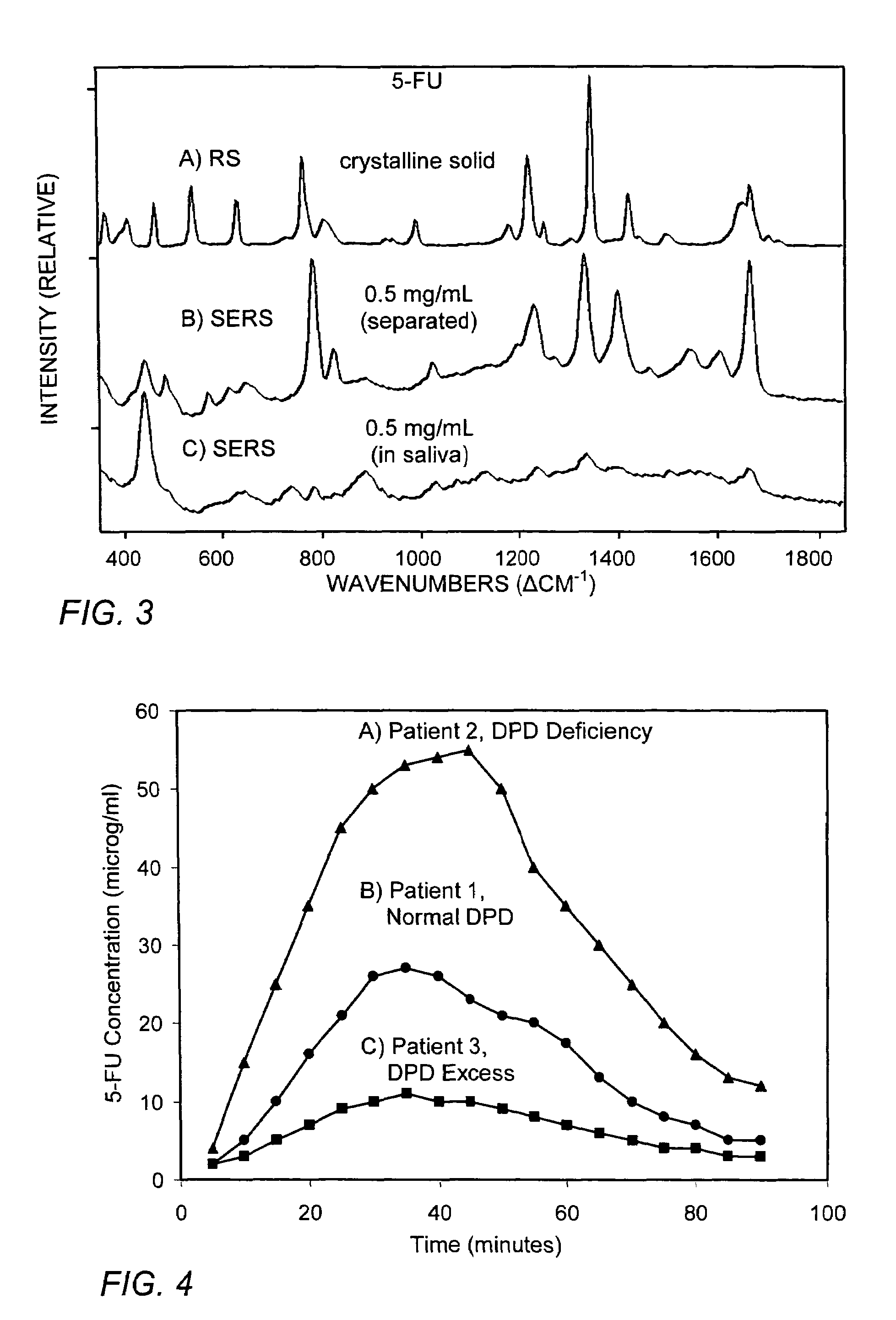SERS method for rapid pharmacokinetic analysis of drugs in saliva
a pharmacokinetic analysis and saliva technology, applied in chemical methods analysis, chemical indicators analysis, instruments, etc., can solve the problems of preventing the use of clinical trials, affecting normal cell growth, and affecting patient health, so as to improve general well-being
- Summary
- Abstract
- Description
- Claims
- Application Information
AI Technical Summary
Benefits of technology
Problems solved by technology
Method used
Image
Examples
example one
Analysis of 5-fluorouracil in Saliva
[0045]The chemical compound 5-fluourouricil (5-FU) is one of the drugs most often used to treat solid tumors and colorectal carcinoma (Malet-Martino M, Martino R, “Clinical studies of three oral prodrugs of 5-fluorouracil”The Oncologist, 1, 288-323 (2002)). In addition to being converted to one of three active forms, 5-FU is converted to an inactive form, dihydrofluorouracil (5-FUH2) by dihydropyrimidine dehydrogenase (DPD). There is a wide genetic-based variation in the amount of DPD in individuals, and the amount of 5-FU converted to 5-FUH2 can range from 15% to 80%. Consequently, employing a “standard” dose of 5-FU has led to severe toxicity, and even death, in individuals deficient in DPD (Diasio R B, Beavers T L, Carpenter J T “Familial deficiency of dihydropyrimidine dehydrogenase”J Clin Invest, 81, 47-51 (1988)).
[0046]A recent pharmacokinetic investigation has shown that 5-FU concentrations in saliva closely match those in plasma, reaching ...
example two
Analysis of Drug Combinations:
5-fluorouracil and Dacarbazine
[0050]In many cases, two or three chemotherapy drugs are used in combination to improve the chance of killing cancer cells, in which case it will also be desirable to measure each of the drugs. In instances in which each of the drugs contains unique identifying SERS peaks, the exact same procedure as that which is described in Example One can be followed. More particularly, the SERS spectra of dacarbazine, 5-FU, and a 50 / 50 mixture of the two compounds, in water, are shown in FIG. 5. Although both drugs have peaks near 785 and 1350 cm−1, which overlap in the spectrum of the mixture, they also contain unique peaks at 1050 cm−1, for dacarbazine, and at 1667 cm−1 for 5-FU, which can be used to identify and quantify these drugs in a mixture. The same may not of course be true for other drug combinations, and additional chemical separation may then be required to enable the analysis to be performed at the desired sensitivity.
[00...
example three
Pharmacokinetic Studies of New Drugs:
Parent Drug and Metabolite Measurements
[0052]A drug typically requires 12 years to research, develop and bring to market, and generates as much as $500 million per year until generic replacements are introduced (generally coincident with patent expiration). Consequently, every day that introduction of a new drug to market is delayed can represent more than one million dollars in lost revenue.
[0053]Clinical trials represent one of the most time-consuming steps entailed in drug development, which trials include measurement of the new drug and its metabolites in blood plasma, to determine pharmacokinetics. The amount of metabolite formed indicates the percent of the parent drug that the body is using, and indicates the dosage size that should be administered. The rate of metabolism indicates how often the drug must be taken. Moreover, in addition to side-effect risks, health factors, such as anemia and possible HIV infection, contribute to limiting ...
PUM
| Property | Measurement | Unit |
|---|---|---|
| volume | aaaaa | aaaaa |
| volume | aaaaa | aaaaa |
| surface- | aaaaa | aaaaa |
Abstract
Description
Claims
Application Information
 Login to View More
Login to View More - R&D
- Intellectual Property
- Life Sciences
- Materials
- Tech Scout
- Unparalleled Data Quality
- Higher Quality Content
- 60% Fewer Hallucinations
Browse by: Latest US Patents, China's latest patents, Technical Efficacy Thesaurus, Application Domain, Technology Topic, Popular Technical Reports.
© 2025 PatSnap. All rights reserved.Legal|Privacy policy|Modern Slavery Act Transparency Statement|Sitemap|About US| Contact US: help@patsnap.com



